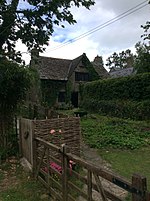Hen Gwrt Moated Site

Hen Gwrt, (English:Old Court), Llantilio Crossenny, Monmouthshire is the site of a thirteenth century manor house and a sixteenth century hunting lodge. Originally constructed for the Bishops of Llandaff, it subsequently came into the possession of the Herberts of Raglan Castle. The bishops constructed a substantial manor house on the site in the thirteenth century, which was moated in the fourteenth. The building was then adapted by the Herberts to create a lodge within their extensive hunting grounds. The lodge continued in use until the slighting of Raglan Castle in the English Civil War. Historical accounts of Monmouthshire traditionally identify Hen Gwrt as the home of Dafydd Gam, the legendary opponent of Owain Glyndŵr and supporter of Henry V, but there is no evidence for this. Work at the site in the early nineteenth showed evidence of the footings of the earlier buildings, which were mapped, but by the time of subsequent archaeological investigations in the twentieth century, all of the stone on the site had been removed for road metalling. Today, no trace of either the manor or the lodge remains, and the moated site is in the care of CADW.
Excerpt from the Wikipedia article Hen Gwrt Moated Site (License: CC BY-SA 3.0, Authors, Images).Hen Gwrt Moated Site
B4233,
Geographical coordinates (GPS) Address External links Nearby Places Show on map
Geographical coordinates (GPS)
| Latitude | Longitude |
|---|---|
| N 51.8315 ° | E -2.8782 ° |
Address
Hen Gwrt Moated Site
B4233
NP7 8TF , Whitecastle
Wales, United Kingdom
Open on Google Maps











